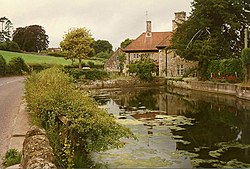Barrow Gurney
| Barrow Gurney | |
| Somerset | |
|---|---|
 Millpond on the Land Yeo at Lower Barrow Mill | |
| Location | |
| Grid reference: | ST535675 |
| Location: | 51°24’16"N, 2°40’4"W |
| Data | |
| Population: | 349 (2011) |
| Post town: | Bristol |
| Postcode: | BS48 |
| Dialling code: | 01275 |
| Local Government | |
| Council: | North Somerset |
| Parliamentary constituency: |
North Somerset |
Barrow Gurney is a village in the north of Somerset, on the B3130, midway between the A38 and A370 near the Long Ashton bypass and Bristol Airport, five miles south-west of Bristol city centre. The wider civil parish includes Barrow Common, and has a population of 349.
The village is close to Barrow Gurney Reservoirs, which supply drinking water for Bristol, and feed the Land Yeo, which river is followed by the B3130 through the village.
History
The Domesday Book of 1086 records that Barrow Gurney was held by Nigel de Gournay, who would have won his lands in Englishcombe, Twerton, Swainswick and Barrow Gurney by fighting for William the Conqueror. His original home must have been Gournay, which was half-way between Dieppe (in Normandy) and Paris.
A Benedictine nunnery was established here about the commencement of the 13th century by one of the Fitz-Hardinges (or Fitzhardinge).[1][2]
Thomas de Gournay was involved with the murder of King Edward II at Berkeley Castle in 1327.[3]
There were three mills on the Land Yeo in Barrow Gurney. The Upper Barrow Mill, which had an Overshot water wheel, is known to have been operating in 1839. By 1866 it was running as a corn mill, and ceased operation by 1935. The Middle Mill was converted to snuff manufacture by Peter Lilly a tobacconist from Bristol around 1800 and became part of the W.D. & H.O. Wills tobacco manufacturing company. It ceased mill operations by 1839 and by 1885 both the leat and millpond had disappeared. The Lower Mill is known have been grinding corn in the 19th century. It was rebuilt in 1909 when an iron overshot watermill of 14 feet diameter was installed and steam power introduced. The mill is still used to produce animal feeds, however the waterwheel and millpond, which remain, are no longer in use.[4]
Barrow Hospital (sometimes referred to as Barrow Gurney Hospital) was a psychiatric hospital which opened in the 1930s. In Second World War the hospital was commandeered by the Royal Navy and became a Royal Naval Auxiliary Hospital before being transferred to the National Health Service in 1948.[5] In 2003 the Avon and Wiltshire Mental Health Partnership NHS Trust announced its intention to close Barrow Hospital by 2008. In 2008 planning permission was granted build 18 luxury homes and 405,000sq ft of office space on the southern part of the site. In 2010, plans were amended to include a 220-bed care home 'village' on the northern part of the site, more housing and fewer offices.[6]
Parish church
The parish church, St Mary and St Edward, has 12th-century origins but were virtually rebuilt by Henry Woodyer 1887–90 for Henry Martin Gibbs son of William Gibbs of Tyntesfield. It has been designated as a Grade II* listed building.[7]
Culture
Barrow Gurney is mentioned in the song 'Drink up thy Zider' by The Wurzels.
It is well known in the Bristol area as a shortcut to Bristol Airport, despite very narrow roads and heavy traffic calming measures that are clearly intended to discourage this.
Outside links
| ("Wikimedia Commons" has material about Barrow Gurney) |
References
- ↑ Information on Barrow Gurney from GENUKI
- ↑ @ |The Priory of Barrow Gurney}}
- ↑ Manco, J. (1995) The Parish of Englishcombe: A History, pp. 2, 4.
- ↑ Bodman, Martin. "Mills on the Land Yeo". Nailsea and District Local History Society. http://somersetrivers.org/PDF/MillsOnTheLandYeo.pdf. Retrieved 28 April 2011.
- ↑ "The Derelict Miscellany : Barrow Hospital". http://derelictmisc.org.uk/barrow.html. Retrieved 2012-04-18.
- ↑ "Care village for old hospital site". North Somerset Times. 19 October 2010. http://www.northsomersettimes.co.uk/news/care-village-for-old-hospital-site-1-684966. Retrieved 19 July 2017.
- ↑ National Heritage List 1311925: Church of St Mary and St Edward
